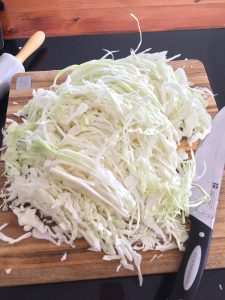Choucroute-Sauerkraut
Région: Alsace
Choucroute or Sauerkraut goes well in soups and stews, especially those made with wine or beer. It is especially good with smoked fish, like

smoked salmon or mackerel. It can be served with smoked sausages or ham.
Raw, it makes a great sandwich filler. It is a crucial ingredient in New York’s famous Reuben sandwiches, together with corned (salt) beef, Gruyère cheese, and chilli-infused dressing on grilled rye bread.
Choucroute-Sauerkraut-Acid cabbagge results from a curing process in which many bacteria appear on the cut edges of cabbage.The added salt draws out the natural sugar stored in the vegetable.Some of the present bacteria act upon the sugar,changing it to acids,resulting in a mellowing of the cabbage.
Storage Jars should be stored in a cool dry place.Once opened Choucroute/Sauerkraut needs to be kept in a refrigerator under its briny liquid where it will last a long time.To avoid contamination use clean utensils to serve.
Ingredients:
1&1/2 teaspoons fine ground sea salt salt to each 450g cabbage.
Equipment:
- Sharp knife.
- Mixing bowl.
- Crock. A 12 Litre crock holds 11 kg of cut cabbage.
- Large saucepan for heat processing.
- Suitable size glass jars and lids
Method:
-
- Choose large, firm,well ripened cabbage. Allow heads to stand at room temperature for
 24 hours to wilt. This makes the leaves less brittle and less likely to break when cutting.
24 hours to wilt. This makes the leaves less brittle and less likely to break when cutting. - Trim away outer leaves and wash heads. Cut into quarters or halves. Remove core or cut finely. Shred cabbage about 2mm thick.
- Weigh the shredded cabbage and add the proper proportion of salt. Mix together in a large enameled, stainless steel or aluminum pan. Leave to stand 5 minutes before packing.
- Place some of the cabbage in a crock. Press gently but firmly to release brine. Add a little more and press. Repeat until crock is full. Brine continues to form for 24 hours.
- If the crock has a fitted lid, place a piece of plastic or a clean white thin cloth over top and tuck inside. Place the fitted lid inside the crock—If no fitted lid, use a heavy weighted plate or clean heavy-duty water filled plastic bag to keep the cabbage immersed.
- Let the cabbage stand in the crock at room temperature for about two weeks. If the temperature is very cool, the process can take as long as six weeks. Remove scum from surface daily, wash cloth or plastic and replace weight.
- Choose large, firm,well ripened cabbage. Allow heads to stand at room temperature for
- Sauerkraut is complete when bubbles stop rising to the surface, although fermentation continues. Taste to check flavour during process. When Kraut suits your taste, remove from crock.Heat to simmering and pack into hot, sterilised jars.If there is not enough cabbage liquid, heat 1 1/2 tablespoons salt to 1 litre of water. Pour into jars, leaving 10mm head space.
- Seal and process in boiling-water bath, allowing 20 minutes for litres, 15 minutes for 1/2 litres.




